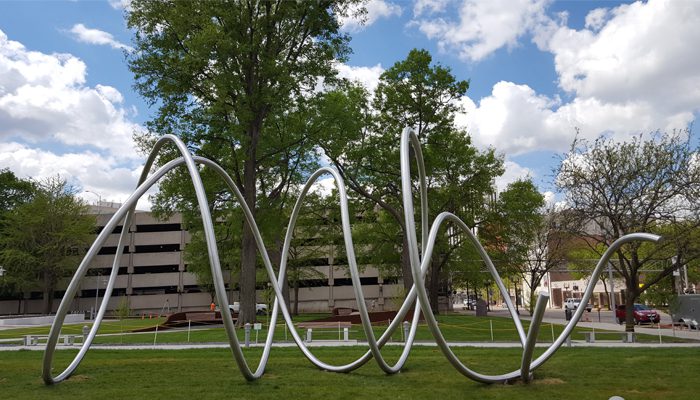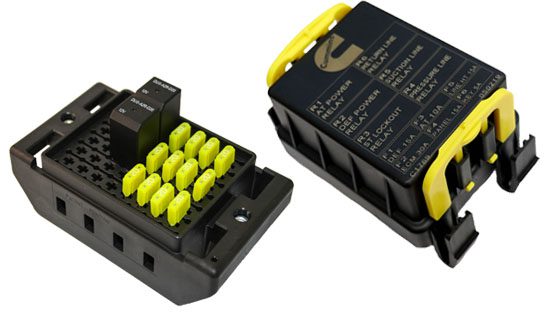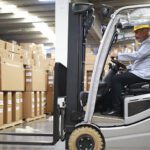Meet the Engineer: When Art and Engineering Collide
For Chief Enterprises’ Bounnak Thammavong, creative design is at the intersection of art and product design.

So often the worlds of science and art are relegated to separate corners despite evidence that the skills, knowledge, and aptitude for one can inform the other to beneficial effect. (Think: Leonardo da Vinci, Samuel Morse, and Beatrix Potter, to name a few). Bounnak Thammavong, senior plastics design engineer at Chief Enterprises spoke with Connector Supplier about his life as both a dedicated design engineer and an accomplished artist.
Tell us how you got into engineering and, specifically, product design.
If we go into the way back time machine… I was a 1980s kid, so I did a lot of LEGOs and a lot of art. My family is full of artists. I was actually slated to go to architecture school. My first love was spaces, building scenes and spaces for people. But then I got into, of all things, pottery making and wheel throwing, painting, and welding. Lots of welding! I grew up working on farms and a lot of welding was required on the tractor brackets and things like that. I never realized that the things I did as a child, were preparing me for an engineering career more than an architectural career. In college, the art degree for design came along as a side thing to architecture. As I got more into that, the design turned into product development and large-scale objects.

Bounnak Thammavong’s sculpture Birds of a Feather hangs in the Des Moines International Airport.
Where did you get your education?
I went to the University of Northern Iowa for my undergraduate degree in design and the University of Iowa for my master’s degree in design. All that was mostly geared toward product development. My engineering experience came through my internships as working, applied knowledge. I also worked with the engineering departments on senior projects during my TA-ships for my graduate degree in design.
How did you fashion your varied interests and experiences into a career?
I noticed there was always this connection between the design side and the engineering side. Engineers would learn how to design rotors for brakes, and all they cared about was how to get things machined and to assure function. The design side of it was the aesthetics; how to make it look good, and how to make it usable for the consumer. That ergonomics-based design work was my real edge over your usual engineer or designer. If we designed a grip for the Harrier jet, or for a Boeing passenger jet, or for the G6 luxury private jet, those are all very different products. On a G6, they’re going to wrap that thing in leather and make it really pretty, and make it fit the pilot’s hand. They’re only going to make 600 of these, right? But if you do a grip for Boeing, it’s got to fit every pilot’s hand, and the volume goes up to thousands. These are two very different objects. My design skills came into play when it came to a “G6” product and my engineering skills came more into play when doing “Boeing” products.
I eventually worked my way into internships doing engineering and product development. The two merged when I finished school and got into injection molded plastics and metal forming for my first job. There was a lot of welding and sheet stamping for clients like John Deere in frames, housings, and covers. On the ergonomics side, there was a lot of plastics injection molding in grips, buttons, handles. The beginning of my career was mainly with Pickwick Mfg. (now Relco/Wabtec), Matrix4 Plastics, and Guardian Electric (now Kelco). Projects involved things like designing a grip for a particular application — move some switches here and there, and make it moldable, along with making housings for a new tractor model that’s coming out. Those kinds of things converged into a product development/product management career path.
How does that apply to your current role?
A lot of my early career path was knee-deep in the design field. Now I’d say it’s 50/50 between the design work and the project management work. I have some touch and feel with all departments because of my project management, from purchasing, through design, release, quality, all that stuff. Being a good project manager makes me a better designer.
Eventually, I became more known as a product manager or a product developer than as an engineer or designer. My advantage was that I knew how the product was built and the development path to the start of production. And that helped me navigate the process and understand, for example, why a project is suddenly two weeks behind. A sudden design change triggers an engineering change that then changes the production process. Being able to simultaneously have a handle on both design and engineering, and working concurrently, shortens the path to product launch.
I’ve been a product developer for a couple of decades now on the plastics side, and Chief Enterprises needed a plastics engineer to solve problems and innovate some new offerings. Specifically, the solving-problems part was our BRIC PDM and its accompanying accessories. They were very successful but needed some minor refinements for efficiency and tooling. Now we’re developing some new products in the BRIC family line. One is the BRIC fusion spin-off. It takes one of our old products and improves the way it’s manufactured and improves the end product by guaranteeing full seal and a more compact object that takes up less space. They’re essentially fuse boxes for the agricultural and commercial vehicle market.

The BRIC (Breathable & Robust Interconnection Center) from Chief Enterprises is a family of American-made power distribution modules designed for the on- and off-road OEM. It provides an IP67 sealed enclosure for critical components, including automotive relays, fuses, circuit breakers and diodes. The BRIC family also includes the BRIC Fusion and the new BRIC mini.
How does your art connect back to engineering?
My large-scale public art projects use all my skills as an engineer. They are anywhere from six feet tall, all the way up to 20 feet tall. Pretty industrial. They get hauled on a flatbed truck. I have to design each project in CAD, I have to weld it, and when it’s all done, I have to install it. I also get to work on my people skills and my presentation skills quite a bit. A lot of these are civic projects that require me to pitch the idea, the way you propose an R&D budget at the beginning of the year.

River Arch (stainless and Corten steel) by Bounnak Thammavong, installed on the Trout Run Trail, Decorah, Iowa
What advice do you have for people pursuing a career engineering or product design?
The advice I would give folks when they’re in school is to do an internship, go experience the world from that product level. Find a club where you do the engineering and design work that you want to do down the road. Join the Baja team at University of Chicago and build a Baja car. Build BattleBots. I took a lot of physics workshops as a kid. I modified cars and tractors as a teenager. I rebuilt vintage electronics and built custom computers in college. Those kinds of projects are really interesting and prepare you for working in a team environment and the fast-paced nature of getting a project done, both the design and manufacturing. Don’t just sit in your room, on your computer, designing in a vacuum. Go do things! Also, have a passion outside of it, because engineering is stressful. You need a release that is healthy. I do kayaking, mushroom hunting, and artwork.
The artwork that I do in private is mainly drawing and small-scale decorative objects. My public-facing art is civic projects, for decorating the town square, essentially. My work in general is based on my recreational experiences, a lot of large scale metal fish and sculptures of landscapes done in stainless steel. It’s very meditative and it helps me work out a lot of stress. I think that’s the main reason I do it. And I get to hang out with other artists and meet interesting people outside of engineering.
See Bounnak’s extensive portfolio.
Visit the Preferred Supplier page for Chief Enterprises to learn more about the company and its products.
Like this article? Check out our other Innovation and Personnel articles, our Transportation Market Page, and our 2024 Article Archives.
Subscribe to our weekly e-newsletters, follow us on LinkedIn, Twitter, and Facebook, and check out our eBook archives for more applicable, expert-informed connectivity content.
- M-Type Connectors Product Roundup - May 14, 2024
- May 2024 Connector Industry News - May 14, 2024
- Testing is Vital for Electronics Performance and Reliability - May 7, 2024





